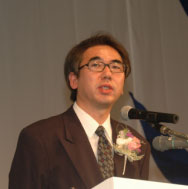Acceptance Speeches
Encouragement Prize : Hideto Yoshioka

Ladies and gentlemen, thank you very much for today’s award. I would like to thank all the citizens of Sakai City, and the members of the Screening Committee.
First, I think I ought to tell you a little about how I came to be involved with Myanmar. I first went to Myanmar in 1995, exactly fifty years after the end of the Pacific War. The country which is today known as Myanmar used to be called Burma, and it was there that, during the Second World War, almost two hundred thousand Japanese soldiers lost their lives. As I’m sure especially our senior guests today must be all too aware, in the Battle of Inphal a Japanese army one hundred thousand strong fought to the very last man. The remains of those one hundred thousand still sleep where they fell, all along the road leading away from that place, which has come to be known as the Road of Bleached Bones. It was the relatives and comrades of those fallen soldiers who first asked me to go to Myanmar, where their friends and loved ones had died, in order to help with the medical aid effort. For example, one veteran, who was over seventy at the time, told me how after he had lost his legs in the battle, a villager had carried him on his back for three, even four hours. The reason he was alive today, back in his homeland, was because that villager, whose name he did not even know, had not abandoned him that day, but had carried him to safety. He said he wanted me to do something for those people. When I went, fifty years on from the war, a great many scars still remained. Sometimes, these scars could be seen as bullet holes in walls, or the wreckage of a tank, but mostly they were to be found in the stories of old people who had lived through the war themselves. There was one village where I spent two years doing medical aid work, which had been the scene of a fierce battle. For many of the old people in the village, I was the first Japanese person they had seen since the war, and one after another they came to me to tell me about how the Japanese soldiers had fought and died. For the first time, I felt I too was really connected with Japan’s history. Many Japanese soldiers, driven back across the Indian border by the British, were given shelter in Burmese villages. So it was that tens of thousands of Japanese survivors were able to return home. I realized just how much those Japanese soldiers owed to the nameless villagers who had helped them. Luckily, no one from my family was sent to the Burmese Front. But I felt I had to do something as a representative of Japan, a nation which can definitely help the people of this country, who live in such poverty under the yoke of an extremely harsh government. So I decided to go there, and I’m still there doing medical aid work now.
I’m happy to say that many Japanese medical experts have joined my efforts, and each year now from 150 to 200 young doctors and nurses come to Myanmar to help with the aid work, before heading home again. All these people work for the sake of that country, trying to improve both the technological and psychological situation, and they are also working for the sake of Japanese society. That is a great pleasure in my life right now. And, while I myself have continued to work in Myanmar, I encourage everyone comes to work with me there to go wherever they choose afterwards. To those who want to work for the sake of Japanese society again, I say please go back to Japan; to those who want to work for the sake of other countries in distress, I say please go to those countries. In this way, little by little the circle has grown wider, and now people can go off to work in various countries. I think my next task will be in particular to support this further.
Lastly, I would like to share with you something that I always feel. In 1945, atomic bombs were dropped on Hiroshima and Nagasaki. Hundreds of thousands of lives were lost in an instant. After returning from Burma, I often thought about war. I would ask myself, why should there be such a terrible taking of life, about why is it allowed to go on? Isn’t it just a waste of life? Recently however, I’ve begun to think about it differently. After the Second War ended, war broke out on the Korean Peninsula. The mainly American Allied Army got pushed back all the way to Jeju Island. MacArthur, commander of the Allied forces, was for dropping an atomic bomb on Heilongjiang, in China. Condemned for his suggestion, he eventually had to return to America.
Some years later saw the Cuban Missile Crisis. The Crisis was of course over the Soviet Union’s attempting to establish missile site in Cuba, and in the end it came down to a test of endurance between Khrushchev and Kennedy over whether or not to press the atomic button. In the end, it was Khrushchev who gave in. The Crisis subsided, and the world escaped from nuclear war. And I thought, why did Khrushchev buckle? Why did MacArthur have to return to America? And I realized: it was because of Hiroshima and Nagasaki. Because of those attacks, both the Soviet Union and the United States knew just what atomic weapons did to the human body, and how tragic the results of using them would be. So, they didn’t press the button. So, Khrushchev buckled, and MacArthur was called back to America. What I’m trying to say is that the deaths of all those poor people who perished at Hiroshima and Nagasaki may over the course of many years have saved the lives of billions. What I had always thought of as pointless deaths had changed into meaningful deaths, and I understood what that meaning was for the first time. When I told this to some people from Nagasaki and Hiroshima, they were truly delighted. As a certain theologian told me at the time, “The dead die twice, once for themselves and once for the people who will live after. Now, in Myanmar I really can see what it means to say that what all those deaths will mean depends fundamentally on how we who have come after live. I try to do what I can for the people of Myanmar, and work for Asian people. Perhaps through that, many Japanese people will be made to think about what peace and life are, and then go out into the world. Perhaps they will go to that place where so many Japanese soldiers died. They won’t be able to bring back their bones, but perhaps they will pick up a feeling from all those fallen men, and even pick up a little bit of life. Then, maybe we, who live at the lowest extreme of the river of history, will think about what we can do for the world, and so completely change the meaning of both the lives and the deaths of those soldiers. I always try to tell people about these things. On August 15th every year, everyone goes to a place of memorial. By doing so, I always say, firstly we become connected with history, and become aware of Japanese history, and then we think about what can be done for the world, and what can be done for Japan. I want to send brilliant Japanese people back to Japan with their faces turned to the world. Thank you very much.
